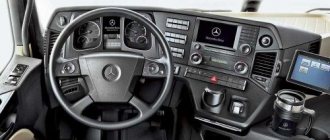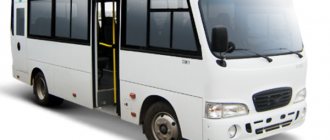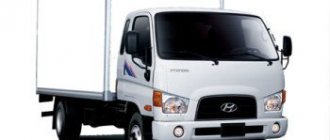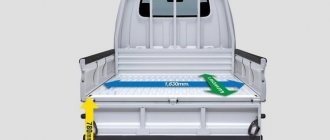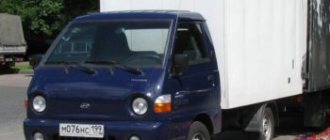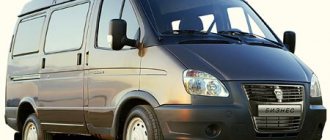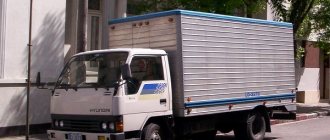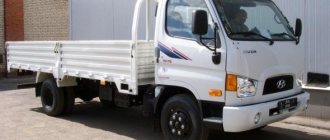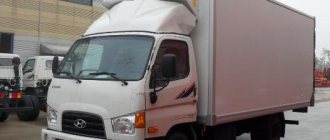One of the largest Korean companies began its promotion to the international market with close cooperation with the Mitsubishi brand. The debut models of Hyundai trucks clearly showed features and technologies inherent in Japanese cars. However, in 1998, the Koreans presented their own development - the Hyundai HD truck. The model was firmly entrenched in the market, but the company did not intend to stop there. As a result, in 2009, a series of Hyundai HD-78 commercial vehicles appeared. The model has not lost the main advantages characteristic of the products of the Korean brand (cost-effectiveness and simplicity), but has added in the quality of elements and operating comfort.
Hyundai HD-78 is a compact truck with a gross vehicle weight of 7200 kg. It is ideal for distribution work and offers outstanding maneuverability. The car is ready for daily city trips. The model is perfectly adapted to Russian realities, so it can generate profit all year round. The car is not afraid of domestic roads and fuel. A variety of types of configurations and cabins, increased load capacity, Korean assembly and a reliable power plant determine the high demand for the car.
The main purpose of the Hyundai HD-78 is transportation over short distances in the suburbs and the city. A huge number of add-ons can be installed on the model’s platform: an onboard cabin, a van, a tow truck and a manipulator. Hyundai HD-78 is currently considered the leader of the Korean brand's lineup. On the Russian market, the model took a place between expensive foreign brands (Scania and Mercedes) and domestic products (ZIL and GAZ).
Among the key advantages of the model, we should highlight the highest performance and quick payback. At the same time, the cost of the car is 10-20% less than that of “classmates”.
It is also worth mentioning the excellent maneuverability of the truck. A small turning angle allows the Hyundai HD-78 to feel confident on narrow streets, among heavy traffic and in the city. Conveniently positioned mirrors and a large windshield help the driver reverse and turn.
Already in the minimum configuration, the Hyundai HD-78 is equipped with an air conditioning system, ABS and auxiliary hydraulic devices, which increases the safety and comfort of vehicle operation.
A little about the history of the model
The HD series of small commercial trucks is derived from similar class vehicles from Mitsubishi. It was cooperation with the Japanese that became the beginning of this line of Hyundai products. The HD78 model itself has been produced since 2008. Its immediate predecessor was the Hyundai HD72.
The index means the total weight of the truck: for the predecessor it was 7.2 tons, and for the Hyundai HD78 it was 7.8 tons. However, for Russian conditions, the total weight is limited by the manufacturer to 7.5 tons.
Externally, the truck changed little - both during the transition in 2008 from the HD72 to HD78 model, and during the 2013 restyling. It is distinguished by the same “Asian” cabin, made in the original Japanese spirit, with a large, somewhat inclined windshield.
External changes have occurred in lighting technology: the headlights have become larger, and the turn signals have increased in size. Turn signals appeared as standard and on the side doors too. The basic equipment also began to have fog lights located in the bumper niches. Another external change is that after restyling, the rear-view mirrors began to be mounted in a European style, rather than in an Asian style, and it became more convenient to look through them.
The design of the cabin suspension also evolved, which began to be installed on rubber shock absorbers recessed in an oil bath. Such shock absorbers are better adapted to frost, and they more effectively soften shocks and shaking when driving on uneven roads.
And finally, one more small change, which, however, was appreciated by consumers. The manufacturer has finally abandoned such a common “Asian” thing as finishing the dashboard “like precious wood”, made of cheap plastic. It was replaced with higher quality and softer plastic.
List of car models in which D4DD was installed
The power unit was created for commercial vehicles. That is why it was installed on Hyundai light-duty trucks and minibuses. List of car models:
- Hyundai HD 78 is a compact truck with a carrying capacity of up to 6 tons;
- Hyundai Counti is a minibus, often used as a minibus;
- Huyndai HD 65 is a light-duty truck capable of transporting up to 4500 kg;
- Hyundai HD 72 is a truck, its carrying capacity is 5 tons;
The unit was installed only longitudinally.
Both yours and ours
The average cost of a Hyundai HD78 of the fourth environmental class with a side curtain body or a manufactured goods van in Moscow is about 1,600,000 rubles, this is approximately half the price of a similar Big Seven truck and 20% more expensive than Chinese products, but discounts and individual offers are possible . Comments, as they say, are unnecessary. The car has been available to customers since August 2013.
BlokAvtoStart LLC , Hyundai ComTrans LLC , and Trans-Real LLC for their assistance in preparing the material.
Design and application features of the Hyundai HD78
The chassis of Hyundai trucks, which are made for Russia, is positioned by the manufacturer as reinforced and adapted to difficult road conditions. And this model is assembled for sale in Russia and the CIS, not only in Korea, but also in China, and here in Kaliningrad.
The car's suspension is leaf spring, with small leaf springs. At the rear there are semi-elliptic, laminated springs with a shock absorber. The front suspension is equipped with a stabilizer bar and shock absorbers. Shock absorbers are hydraulic double-acting, telescopic type on the front and rear axles. The brake system is equipped with improved discs with increased area. The front wheels are single, and the rear axle is paired.
The main purpose of the Hyundai HD78 is transportation over short distances around the city and on suburban routes, within the region. The chassis has a high degree of versatility: a large number of special add-ons can be installed on its platform. The most popular and widespread of which are:
- The vans are isothermal, treated with polymer or coated with auto enamel. They consist of laminated plywood and clad metal.
- Refrigerated vans that can maintain the required temperature for a long time. With cooling compressor. The insulation is made using polystyrene foam or polyurethane foam, with a thermal conductivity coefficient of 0.035 W/sq.m;
- Manufactured goods vans made of clad metal, plastic and laminated plywood. They are coated with auto enamel and galvanized.
- Bread vans, with different numbers of trays. They also have isothermal properties.
- Vans with a tail lift – loading from a mechanized tailgate platform.
- Crane-manipulator installations.
- Car tow trucks.
The truck is very compact and maneuverable, ideally suited for working in the cramped conditions of a modern city. A carrying capacity of 5 tons and a body volume of 20 to 35 cubic meters allow the owner to profitably handle large quantities of goods for delivery to customers and (or) distribution to stores.
Adaptation to Russian conditions is not empty words. In addition to a reinforced frame and suspension, this also includes additional fuel filtration, increased ground clearance, and a reliable heating unit before starting the engine in subzero temperatures.
Hyundai HD78 with CMU.
The cabin is quite spacious for such a compact truck, fully three-seat, heated, ventilated and air-conditioned, with ergonomic controls. Rear view mirrors are large in size and heated. There is a hydraulic power steering system, ABS, air conditioning.
The service network is well developed, and spare parts are not a problem to find. Most often, they are already available in any city (more than two hundred service centers operate across Russia); those purchased “to order” rarely have to wait. Consumables, lubricants, replaceable components and parts are not only not in short supply, but also relatively inexpensive. On the freely accessible Russian-language Internet you can find manuals and instructions for the operation and repair of Hyundai trucks, and if you wish, maintain the good technical condition of the vehicle yourself.
In general, if we talk about modern trucks, then, in my opinion, most failures are caused by illiteracy and (or) carelessness of drivers, and the design flaws inherent in any vehicle have nothing to do with it!”
Equipment options
The truck can be purchased in a standard (STD) or luxury (DLX) modification.
Initially, each of them includes: power steering; tow hook; heated rear view mirrors; tachometer; spare wheel; brake force regulator; mountain brake; interior heater; special floor covering; passenger sun visor; ABS system with electric brake force distributor; bumper painted in the color of the cabin; electric windows; central locking; front fog lights. In the DLX configuration, an audio recorder with a radio receiver, speakers and an antenna is added to the above (in the STD - only audio preparation), a tint strip on the top of the windshield, and a digital clock.
Hyundai HD78 with an extended wheelbase and a one-and-a-half cab.
Air conditioning, power take-off, a more comfortable driver's seat on a spring suspension with lumbar support, a double brake booster - these are all additional options for an additional fee for both the first and second configuration options.
In addition, Hyundai HD78 trucks are supplied with an extended (Long) base, as well as with a one-and-a-half cab, in which a compact berth is equipped by adding a width of 30 cm.
Technical characteristics of the Hyundai cab and cargo platform
The cabin of the Hyundai HD-78 truck is all-metal, with reinforced safety zones. The design provides for full lifting using torsion elements. The cabin is made using an aerodynamic design. Damping rubber cushions provide sound insulation and reliably protect against vibration.
Hyundai HD78 cabin interior
The cabin is equipped with comfortable high seats, which make long journeys more comfortable. The driver's seat is spring-loaded, the design allows you to change the angle of inclination and is adjustable in the longitudinal direction. In addition to increased ergonomics, the backrest of the central seat transforms into a table, and the shift lever can be rotated to the side. The steering wheel can also be adjusted for a more comfortable driving position.
The area of the windshield and side windows is large and does not limit the driver’s field of vision in urban environments. The windshield is cleaned by paired windshield wipers driven by an electric drive. When operating the windshield wipers, you can select one of three modes. Good visibility in the dark and in bad weather is provided by double headlights and fog lights. The cabin of the Hyundai truck has air conditioning.
The cargo platform of the car has a steel frame and is lined with wood. Square pipes are used as load beams. The sides are made of metal and recline. The base for moving cargo is low, which allows you to quickly load the machine.
View from the driver's workplace of Hyundai HD 78
Hyundai HD78 truck engine
The HD78 is equipped with a high-torque 4-cylinder diesel engine produced by Hyundai, model D4DB. The engine is equipped with a turbocharger and an intermediate equipment system. The power of this power unit is 140 horsepower (in the updated version - 150 hp) and a working volume of 3,907 liters. Unlike most similar motors in this class, D4DB has a very wide operating range. It not only pulls well at the bottom, but also revs dynamically up to 3 thousand rpm. Another advantage of this diesel engine is that it is not stuffed with complex electronic systems, and this makes routine repairs much easier and faster. In general, access to the engine is very well thought out, in particular to its most frequently serviced components.
The power unit on cars of earlier years of production complied with Euro-3 environmental standards. Now this is Euro-4, the Common Rail electronic injection control system. Both the previous and updated versions of the engine are capable of accelerating the truck to 120 km/h. Diesel fuel consumption in the urban cycle is at the level of 15-18 liters per 100 kilometers. The fuel tank capacity is 100 liters. The maximum engine torque is 372 N*m (at 1400 rpm)
Let's go!
Even the founder of the family, the old Hyundai HD72, never complained about the dynamics, and with the advent of the HD78 with a power of 140 hp, some carriers even thought about how to load more of such a frisky “filly”. The 78th was only slightly inferior in throttle response to its predecessor when it moved to the third environmental class, having lost the fuel injection pump and gained an electronic accelerator pedal. But everyone has long forgotten about this fact, since this generation’s efficiency turned out to be excellent. Skilled drivers managed to achieve 12–13 liters per hundred on the highway, and this was with a loaded car!
The upgraded engine, in addition to meeting Euro 4 requirements, added another ten horsepower, and the torque increased by almost 200 N∙m (from 380 to 579), so everything is in order with the power-to-weight ratio. All that remains is to achieve more precise operation of the gearbox cable drive, and the ABS system would also not hurt, at least as an option.
Fault overview
D4DD is a very reliable unit. But no one is immune from constructive miscalculations.
D4DD rarely causes problems for its owners. Most often, malfunctions occur due to careless handling of the engine. If you perform maintenance on time and do not overload the motor, then most problems can be avoided.
Typical malfunctions and methods for eliminating them:
- The most common problem is a frozen crankcase ventilation valve. This problem was first encountered in the winter of 2009. When the temperature drops below -10, the condensate that has accumulated in the metal tubes that connect the valve to the turbine freezes. The solution to the problem is to remove the valve; in addition, you need to plug the hose going to the oil pan. This will help get rid of this problem.
- Turbine failure is also not uncommon. Most often this occurs due to cartridge wear. It occurs due to dust entering through the air filter. As practice shows, car enthusiasts rarely monitor the condition of filter elements. The worst case scenario is that oil gets thrown into the intake; in large quantities, the lubricant can act as fuel for the diesel unit. Simply put, the engine can go haywire.
- Oil consumption at high mileage. This problem occurs in almost everyone; in most cases, replacing the valve stem seals will help. If after repairing the cylinder head the fault does not go away, it is recommended to overhaul the engine, otherwise oil will begin to enter the combustion chamber. There is a risk that the engine may break down, after which there will be nothing to repair.
- Malfunction of fuel injectors. This problem can be easily identified by the following signs: uneven engine operation;
- knocking in the cylinders;
- increased engine heating;
- drop in power plant power;
- black exhaust;
- increased fuel consumption.
In order to eliminate a malfunction of the Common Rail system, you need to check all the injectors with a control device and then replace the faulty ones. After this, you will need to adjust the fuel system. Knocking in the area of the cylinder head cover is most often caused by increased valve clearances. Fixing the problem is quite simple: you need to adjust the thermal clearances of the valves. Almost any car enthusiast can perform this action.
Transmission. Steering and brakes
The clutch is dry, single-disc, hydraulically driven. The gearbox is mechanical, with a power take-off shaft, 5 forward gears and 1 reverse gear. A power take-off unit with a mechanical or pneumatic drive is mounted with the gearbox. The cardan shaft is tubular, on an intermediate support with a universal joint, needle bearings, and a sliding fork. The rear axle is driven, with a single-stage transmission. The gearbox gear is hypoid, the differential gear has rectangular teeth.
The truck's gearbox (its model: M035S5 (OverDrive)) sometimes causes fair criticism. It has an outdated design with a cable-driven lever, which is quite susceptible to failures and unclear shifts when operating in lower gears. That is, the modified Hyundai HD78 inherited a five-speed gearbox from the previous model of the Korean HD72 truck.
The steering mechanism is equipped with an effective hydraulic booster, which allows the driver to change the direction of movement of the car without any load or stress. The brake system is hydraulically driven. The front wheels have a disc mechanism, the rear wheels have a drum mechanism with pads. The parking brake system is a drum with shoes on the secondary shaft of the gearbox, the drive is cable.
Under-cab changes
This is where the fun begins.
The upgraded engine received the D4GA marking (from the previous D4DD) and is equipped with a Common Rail direct fuel injection system manufactured by Denso. What catches your eye is the enlarged radiator, directly above which is an impressively sized expansion tank for the cooling system. In previous versions, this unit was attached to the right mudguard below the radiator level. This led to the fact that, at a normal level of antifreeze in the expansion tank, there might not be enough coolant in the radiator. For full control, you can’t do without raising the cab! Now this design flaw has been eliminated, and the power steering reservoir, whose place is now occupied, has moved slightly back. Everything else remains in place, except that the components of the exhaust gas recirculation system have become more bulky, making the cylinder head visually larger than it was before. The fuel system controller is located right there, on the left side of the cylinder block. And at the back, as already mentioned, there is an additional casing. Technical characteristics of Hyundai HD-78 Euro 4
| Chassis curb weight, kg | 3155 |
| Engine | D4GA, Euro 4 |
| Working volume, cm3 | 3907 |
| Power, hp | 150 at 2800 min-1 |
| Torque, N∙m | 579 at 1600 min-1 |
| Transmission | Mechanical, 5/1 |
| Clutch | Dry, single disc |
| Braking mechanisms of all wheels | Drums |
| Fuel tank capacity, l | 100 |
| Suspension | Spring on the front and rear axles |
| Tires | 7.00×16-10PR 5.5Fx16 |
| Maximum speed, km/h | 125 |
Technical specifications in numbers
- Wheel formula – 4x2.
- Length – 5.3 m (6.63 m – long version of the chassis), width – 2.1 m, height – 2.285 m.
- Wheel track – 1.665 front and 1.495 rear.
- Overhang front: 1.12 m, rear: 1.36 m (1.735 m for the long version).
- Ground clearance – 235 mm (maybe a little less, but not less than 200 mm).
- Wheelbase - 2.55 m or 3.57 m (extended chassis).
- Curb weight – 2.54 t (2.825 t for the long version).
- The load on the front axle is 2.8 tons, on the rear axle – 4.7 tons.
- Tire size – 7.00xR16-14PR. Disc size – 6.00GSx16 SDC-127.
- The maximum lifting angle is 0.322tg.
- The minimum turning radius is 5.2 m (7.3 m in the long version).
Device and technical characteristics
The Hyundai HD 78 truck is built on a frame chassis with rear axle drive. The suspensions are equipped with semi-elliptical leaf springs with hydraulic shock absorbers. The manufacturer produces cars with standard (2820 mm) and extended (3775 mm) wheelbases. All modifications are equipped with 7.00*R16-14PR tires (dual rear) and 6.00GS*16 SDC-127 stamped steel wheels.
To stop the truck, a 2-circuit hydraulic brake system with drum mechanisms is used. The design includes a vacuum booster and an ABS anti-lock braking system. Cars that comply with the Euro 5 standard received additional VDS equipment to maintain directional stability. When parked, the vehicle is held in place by a mechanically driven transmission brake.
Truck specifications (long wheelbase):
- wheel formula - 4*2;
- installation length for installation of superstructures - 4880 mm;
- maximum speed - 137 km/h;
- turning radius - no less than 7.3 m.
Power unit
The truck is equipped with an in-line 4-cylinder D4GA diesel engine with an adjustable boost system and a compressed air intercooler. With a cylinder displacement of 3933 cm³, the engine develops power of 140-170 hp, peak torque at 1400 rpm. is 372-608 N*m. The engine design includes electronic fuel injection control and a particulate filter; exhaust emissions meet Euro 4 or 5 requirements. The transmission consists of a dry 1-disc clutch and a 5-speed manual gearbox.
Load capacity
The vehicle's carrying capacity is in the range of 4775-5205 kg, depending on the type of superstructure installed and the length of the wheelbase. The capacity of the onboard platform measuring 5020*2200 mm is 10 European standard pallets. When installing a vacuum tank with a capacity of 4000 l, the load capacity is reduced to 4775 kg due to the installation of a pump with a capacity of 240 m³/h driven by the power take-off.
Fuel consumption
The use of an adjustable turbocharger has reduced fuel costs. The average gasoline consumption on the Hyundai HD 78 is about 14 liters per 100 km. According to owners' reviews, in dense city traffic in winter and when fully loaded, consumption increases to 18-19 liters. The volume of the fuel tank installed on the left side member of the frame is 100 liters. On some vehicles, the tank is protected by an underrun bar, which reduces the risk of tank destruction in a side impact.
Electrical equipment
The electrical circuit of the truck is built according to a 1-cable diagram with the negative terminals connected to the body and frame. DC sources are 2 batteries connected in series to produce a voltage of 24 V. An alternating current generator with a semiconductor rectifier is located on the engine. To protect circuits from short circuits, fusible inserts located in the interior unit are used. The fuse diagram is printed on a sticker located on the protective casing of the unit.
Dimensions and weight characteristics
The loaded chassis with a long wheelbase without driver and passengers weighs 2755 kg. The total weight of the truck allowed by the manufacturer reaches 7800 kg, while the permissible load on the front axle does not exceed 3000 kg.
Overall dimensions of the vehicle (long wheelbase version):
- length - 6630 mm;
- width - 2000 mm (excluding mirror extension);
- height (to the cabin roof) - 2270 mm;
- the length of the front and rear overhangs is 1120 and 1735 mm, respectively;
- ground clearance (at full load) - 235 mm.
Features of the manipulator
The manipulator mounted on the chassis of a Hyundai HD 78 truck is equipped with a hydraulic or cable drive. Both options are adapted for operation at low air temperatures. The hydraulic manipulator is equipped with an extendable boom with a lifting capacity of up to 4000 kg; at the end it is possible to install a pincer gripper, a small-sized bucket or a drilling rig. Cable machines are used as a tower; after being equipped with an additional basket, they are used to lift personnel to the place of work.
The hydraulic unit has a mass of 1080 kg and is located in the space between the cabin and the onboard platform. The control panels have 7 levers each, located on the left and right sides of the car. The gearbox has a separate gearbox to drive the gear pump. The supply of working fluid is located in a separate container with a volume of 32 liters. The design of the equipment includes a safety element that prevents lifting loads with excessive weight. To increase stability, 2 hydraulically driven outriggers are used.
Cabin Hyundai HD78
The truck's cabin is three-seater, short (but modifications with an extended cabin and a compact berth 300 mm wide are also available).
The wide door opening and grooved step provide easy and safe access to the cab. To open access to the engine, the cabin can be freely tilted forward 55 degrees manually by one person.
The salon is quite spacious. The range of adjustments in the driver's seat is very limited, but it is quite enough to comfortably accommodate both short and tall drivers. Moreover, the steering wheel is also adjustable for reach and tilt. The driver's seat is quite hard, but overall comfortable, with lateral support. But it’s better not to be greedy when buying and buy a car with a more comfortable seat (additional option).
Inside the cabin there are many different shelves, pockets and niches. All levers, switches, keys and indicators are located ergonomically and conveniently. There is no “overkill” with all sorts of additional devices that distract the driver’s attention, but everything necessary is at hand, including an indication of open doors, an internal lighting system for the superstructure. The back of the central seat can easily be turned into a table during parking, and there is a gear shift lever the ability to turn it on its side so that it does not interfere with movement around the cabin.
Internal inconsistency
There are also minimal changes inside the cabin. I was able to inspect two configuration options – standard and the so-called “luxury”. Both versions are well known from previous generations. The standard version is equipped with primitive seats, covered with a terrible texture, but wear-resistant leatherette, which is simply impossible to sit on if the car has been standing in the sun for an hour. Adjustment of the driver's seat is simple - in only two directions; you just have to forget about things like lateral support or sound insulation.
In contrast to these shortcomings, the material of the instrument panel and steering wheel is pleasant to the touch, and the panel is not exposed to any extraneous squeaks. In 2013, the instrument cluster lost its tachometer, this saving is incomprehensible and even annoying to me, but the odometer is now electronic instead of archaic mechanical “wheels”.
The “luxury” version is equipped with a normal driver’s seat: with developed lateral support and good combined upholstery. True, the adjustments are also sparse, but their range is acceptable to get things done normally. The luxury instrument panel has rather funny wood-look inserts, a simple audio system with terrible acoustics, but progress in the instrument cluster! There is a tachometer and a clock here!
According to the sales manager, the price difference between these versions is minimal - only about 10,000 rubles, which is approximately 0.6% of the cost of the car. However, gentlemen, potential consumers, do not rush to order an improved finish for yourself! The manufacturer supplies cars according to the principle “what God has provided,” and in order not to get into trouble, sellers promise only to try to get the required equipment, but so you have to take what is available. Don’t forget that this is a purely budget product, and you shouldn’t complain too much about the lack of a headrest and “music”.
Another and, perhaps, more significant note on ergonomics, carried over from previous generations of the Hyundai HD78, is the location and design of the right rear view mirror. There is nothing wrong with the fact that it is unified with the left mirror, but then please modify the stand and additionally install a “sphere”. Yes, the price of the car will go up by a few pennies, but thousands of drivers will definitely say “thank you”!
How can you save money?
This question worries all motorists. Let's see what could be causing the increased gasoline consumption, and what can and should be done to reduce fuel consumption:
- If a car consumes a large amount of fuel, this may be caused by faults in the car itself. You may need to have it diagnosed at a service center.
- Reduce the load on the car, do not overload it.
- Change your driving style. When turning on high speed, do not accelerate.
- Even driving slowly in traffic uses gas, so plan your trips when there is little traffic on the roads.
- On the highway, it is best to use the speed called cruising speed, at which fuel costs will be lower.
- Choose the right gear for the car and drive in it.
- Buy the right wheels. Since they also affect fuel costs.
Smooth road and low consumption, see you again!
Reviews from owners and drivers
According to the vast majority of people who know the Hyundai HD78 first-hand, this truck is one of the best in its category in terms of price/quality ratio. A successful engine - reliable, not capricious and high-torque (and when necessary, very revvy). True, fuel consumption in urban conditions is slightly higher than the indicators indicated by the manufacturer. But this surprises few people these days. Very easy to control and maneuverable, like a car.
Good load capacity and capacity – 5 tons, 10 pallets. A good margin of safety for all components and parts of the structure. Chassis, suspension, engine, comfort, handling - everything in the Hyundai HD78 is “tailored” for daily intensive work. The car is good for short and medium distances. This is a truck for daily work. For everyday work. It quickly pays for itself and begins to make a profit. There is nothing superfluous, but everything necessary for daily work is present.
The downside is that the seat in its basic version is not very comfortable (“like a stool”); poor cabin sound insulation; its susceptibility to corrosion; problems with springs if you regularly practice fully loading or overloading the machine. Springs and cushions can be reinforced with GAZel sheets.
Interesting reviews from owners who themselves work behind the wheel of purchased new Hyundai HD78:
“Now the mileage is more than 300,000 kilometers. I changed the steering cross, the suspension bearing, the steering ends and the outer bearing of the front hub.”
“Over the entire run, I changed the kingpins, suspension bearing and crosspiece at the bridge at 200 thousand km, replaced the steering tips at 150 thousand km, the heater radiator leaked - replaced it with a VAZ copper-brass one from the eight; the hose on the power steering burst (cracked), the outer bearing of the front hub recently became damaged - nothing else has been repaired yet.”
“I bought a new HD-78, it has already covered almost 170 thousand km, I only changed consumables, i.e. oils, filters, brake fluid, antifreeze and once alternator belts at 150 thousand, although dealers change it after 40 thousand if you put it under warranty . I didn’t put a warranty on it and don’t see the point, the car is quite reliable. So my friend put the 78th under warranty and, as they say, threw away a little over a hundred thousand rubles for this guarantee.”
Review of Hyundai HD 78 (2012)
I welcome everyone to this forum. So I decided to write a sequel about my truck, which has been helping me with work and personal matters for more than two years now. I rarely drive it myself, since I have a driver for this purpose, but I know all the pros and cons of the car, since it is paid for out of my pocket.
So the mileage has already exceeded 30k, and oddly enough, nothing criminal happened to the car. It still starts and drives in any weather, carrying its 5-6 tons of cargo. I don’t load anymore, as I try to take care of the car. And there is no point in overloading, you will spend more on repairs and plus downtime during repairs, which is also a loss for my organization. At first I was very afraid of winter use, but as practice has shown, it was in vain. Starts in any frost and without problems. I fill diesel fuel exclusively with Lukoilovskaya and have never had any problems. In the first year I used Liqui Moly anti-gel, in the second year I did not use it, I did not notice a difference. As I understand it, there is no point in antigel; after all, we don’t live in the north. Fuel consumption averages 20 liters per hundred +/- 2 liters depending on load and time of year. The car comes from Korea only as a chassis; the superstructure on the chassis is made in Russia and, as a result, after the first winter everything rusted except for the aluminum sides and rear doors. Every spring, the driver, armed with a drill with a stiff brush, removes the rust and uses a spray gun to paint the superstructure on the street. Enough for a year. I would also like to advise everyone who purchases this car to wrap the entire face in film again. I didn't do it now I regret it. The whole face is a rusty point. The flying stones knock off the paint and the chip immediately rusts. As far as I understand, there is no primer under the paint at all. In terms of corrosion, the car is certainly not very good. I examined similar cars of other brands, such as Mercedes Daf Man Scania Juveco, and did not find any such problems. To tell the truth, the cost of these cars is much higher than mine, but I would still like to have a car of higher quality in this regard. Another thing I don’t like is the knocking sound of the cab tilting mechanism. It rattles on bumps, no matter what they did. Of course, they reduced the noise as best they could, but they didn’t completely eliminate it. It’s like this is all that I don’t really like one way or another.
Otherwise, the car is excellent, reliable, and has never let us down. It's worth the money, and has already earned its money's worth. For the winter I bought winter tires for the four rear wheels for 7 grand. wheel. On the advice of friends who have such cars, we bought Chinese factory tires, which are made under Cooper's license, I don't remember the name. We drove off through the winter, we don’t know any grief, and now we continue to drive, since it rows in the mud very well, unlike its original track tires, on which it slips even on grass.
This year the warranty expired and the car switched to self-service, which saves a lot of money. The last maintenance cost 20 thousand. The oil was changed, diagnostics were carried out, all the filters were changed, including the fuel one, everything was injected from below, the same money was purchased for topping up the oil, since the engine is turbocharged and the oil eats up, but not critically.
Yes, I forgot to add one more feature of this car. Being loaded and in motion, you need to be very careful in terms of distance, since the car has drum brakes at the rear. Because of them, the braking distance of the car is somewhat longer compared to competitors equipped with disc brakes. In principle, when you know this, it does not create problems when moving.
Here, in a nutshell, is everything I would like to tell you about my truck. If you have any questions, please ask, I will try to answer as best I can.
Service regulations
The D4DD engine can be considered a standard of reliability. But even a trouble-free unit can be killed if maintenance intervals are not observed. It is important to use only high-quality spare parts and consumables. With proper maintenance, the unit can travel more than 500 thousand kilometers without major repairs.
Motor oil is the most important fluid in the engine. If the engine is able to operate without antifreeze, then without lubrication it will simply seize. The choice of lubricant should be approached wisely. The engine runs great on mid-priced oils. The manufacturer recommends using CJ-4 10w-40.
Service schedule:
- It is recommended to inspect drive belts every 20 thousand kilometers; it is worth checking the elements for cracks and other defects. If there is a lack of confidence in the belt, it is recommended to replace it immediately.
- There is no timing belt in the engine. This frees the car enthusiast from worrying about bending the valves. The timing mechanism requires virtually no maintenance. All you need to do is adjust the valves every 30 thousand kilometers. If this is not done, a knocking sound may occur in the area of the cylinder head cover;
- It is recommended to replace the coolant after 100 thousand km. mileage You also need to monitor the condition of the pump and pipes. Inspection of the cooling system for leaks must be carried out regularly - once every 20 thousand km. If you neglect this rule, significant problems with the stove may arise, and the motor may overheat.
- Glow plugs do not require attention, but if starting the engine becomes difficult, it is recommended to replace them.
- Air and fuel filters should be changed every 30 thousand kilometers;
- It is necessary to change the oil every 10,000 kilometers; this rule will keep the engine clean throughout its service life.
- It is recommended to adjust the fuel system once a year to help keep the engine in optimal condition.
The condition of the turbocharger must be carefully monitored; if this is not done, then when worn, oil will begin to flow into the intake, which will cause engine wear. Lubricant is an excellent fuel for diesel units.
External identity
On the outside, the updated truck has minimal differences. Except that the fog lights now have transparent glass, devoid of lenses; a careful look will also notice the casing between the rear wall of the cab and the body. If you stop at a gas station, the driver, already familiar with the previous generation Hyundai HD78, will appreciate the protective cap that appears on the lock of the fuel tank lid; previously, the unprotected lock cylinder would fail after a couple of years. Also, if you look closely, you can see a protruding part of the fuel pre-fuel pump housing on the tank. That's probably all the external differences.
